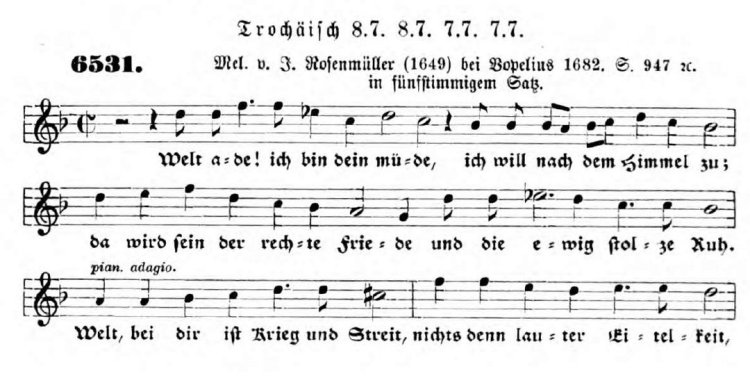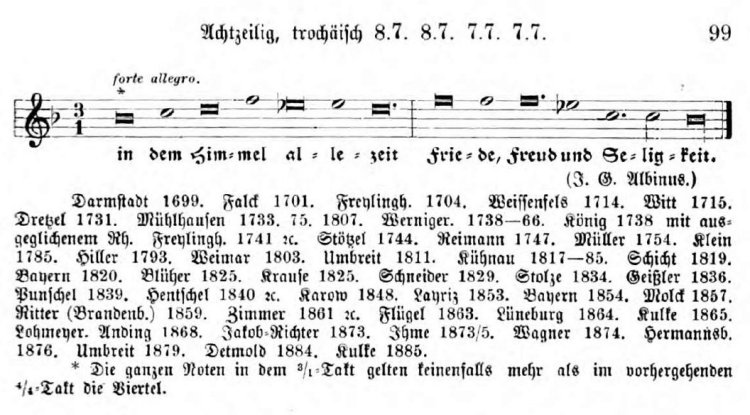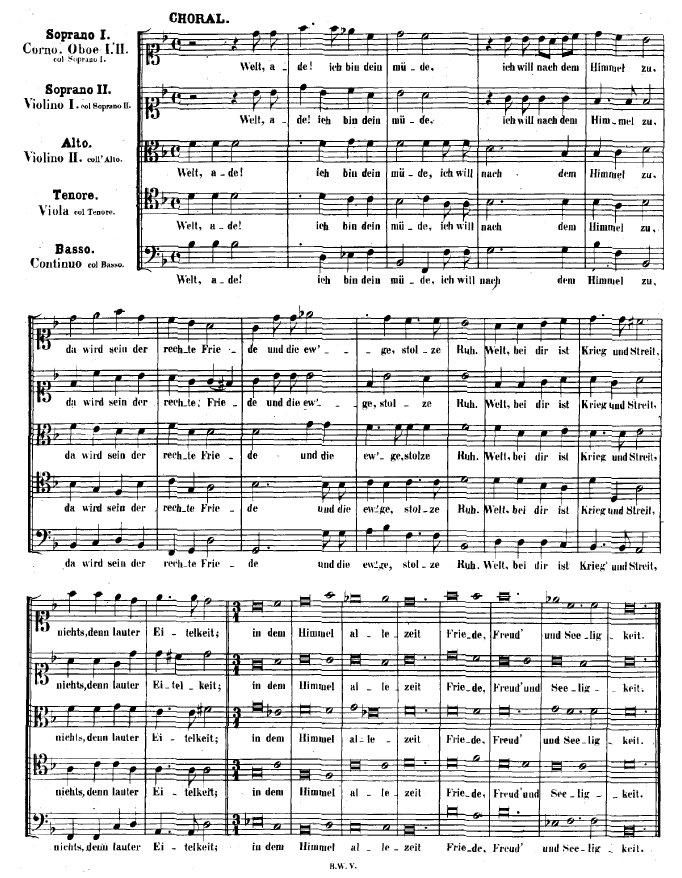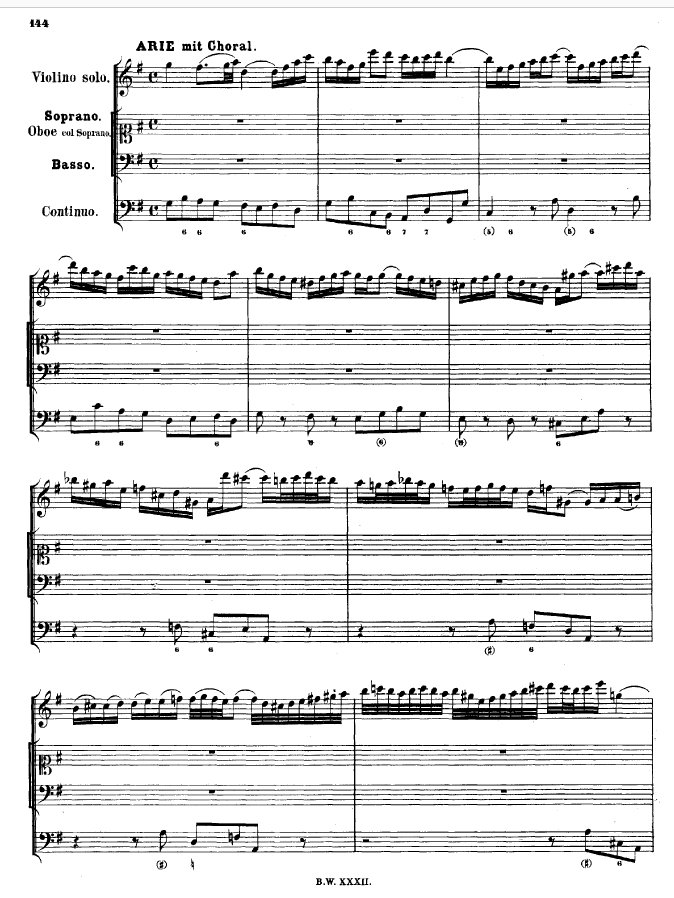|
|
Chorale Melodies used in Bach's Vocal Works
Welt, Ade! ich bin dein mude |
|
Melody & Text | Use of the CM by Bach | Use of the CM by other composers |
| |
|
Melody & Text: |
|
The melody is identified as Zahn 6531. The melody was composed and harmonized by Johann Rosenmüller (1615-1684), assistant cantor at the Thomas School in Leipzig, and set to the text of his friend, Johann Georg Albinius (1624-1668, rector of the Cathedral School at Naumberg, for a funeral at the Leipzig Nikolaus Church in 1649. Bach’s source in Cantata BWV 158 was Rosenmüller’s melody in his harmonized five-part setting (SSATB) published by Gottfried Vopelius (1645-1715) in his Neu Leipziger Gesangbuch (NLGB, Leipzig, 1682). |
|
Melody: Zahn 6531 |
|
Chorale Melody: Johann Rosenmüller (1649) |
| |
|
Text: Welt, ade! ich bin dein müde
Author: Johann Georg Albinus (1649) |
|
Albinus was born at Unter-Nessa, Saxony, in 1624. He was educated at Leipzig and in 1653 was appointed Rector of the Cathedral School, Naumburg. In 1657 he became pastor of St Othmar’s Church there. He died in 1679. BCW Short Biography, http://www.bach-cantatas.com/Lib/Albinus.htm; Biography, http://www.hymnary.org/person/Albinus_JG.
Source: Johann Sebastian Bach, Bach’s Chorals. Part I: 2 The Hymns and Hymn Melodies of the Cantatas and Motetts, by Charles Sanford Terry (Cambridge University Press, 1915-1921). 3 vols. Vol. 2. March 20, 2014. http://oll.libertyfund.org/titles/bach-bachs-chorals-vol-2-the-hymns-and-hymn-melodies-of-the-cantatas-and-motetts, Cantata CLVIII. |
|
Johann Georg Albinus’ 1649 funeral chorale, “Welt, ade! ich bin dein müde” (World, farewell, I am weary of thee), addresses a favorite Bach blended theme of “Death and Dying” and “Patience and Serenity.” It is expressed in the Cantata 158 extended bass aria with interpolated soprano text and the Johann Rosenmüller melody, in the same dictum in both voices. This funeral hymn also is found at the end of Cantata 27, “Wer weiß, wie nahe mir mein Ende? (Who knows how near my end is to me?) in Rosenmüller’s five-part chorale setting of the first stanza. Bach’s predecessor Johann Kuhnau set all seven Albinius verses in his pure-hymn cantata, “Welt adieu, ich bin dein müde,” and the text is found with melody and bass in the home devotional Schemelli Gesangbuch (SG) of 1736, with its emphasis on “Death and Dying” and “Patience and Serenity.”
The chorale “Welt, ade! ich bin dein müde” (World, farewell, I am weary of thee), was first printed on a broadsheet for the funeral of Johanne Magdalene, daughter of the Archidiaconus Abraham Teller, of St. Nicholas’s Church, Leipzig, who died Feb. 27, 1649. The words of the text, a Pilgrimage song, were written by Johann Georg Albinus (1624-1668), Leipzig-educated rector of the Cathedral School at Naumberg. The incipit is based on 2 Corinthians 5:8: “Wir sind aber getrost und haben vielmehr Lust, außer dem Leibe zu wallen und daheim zu sein bei dem Herrn” [Luther 1912] (We are confident, I say, and willing rather to be absent from the body, and to be present with the Lord). The melody was composed and harmonized by Johann Rosenmüller (1615-1684), assistant cantor at the Thomas School in Leipzig and Albinius’ friend since the latter had been a theology student at the University of Leipzig for eight years, 1645-1653. The setting is found in Rosenmüller ‘s Kern-Sprüchen, 1648 and was printed in an appendix to the funeral sermon as a four-part “Cantionalsatz” (Protestant hymn).
Later, the funeral hymn was published in the Brandenburg Neu Vollständiges Gesang-Buch (Bayreuth, 1668), the Geistliches Neuvermehrtes Gesang-Buch (Schleusingen, 1672), and Albinus's Geistlicher geharnischter Kriegesheld (Leipzig, 1675). |

 |
| |
|
Hymnal versions Bach may have known: |
|
Bach’s source was Rosenmüller’s five-part setting (SSATB) in B-Flat Major with his melody (Zahn No. 6531) published by Gottfried Vopelius (1645-1715), cantor of St. Nicolas in Leipzig in his Neu Leipziger Gesangbuch (NLGB, Leipzig, 1682). It is listed as No. 372 in the omnes tempore section under “Death and Dying” as a death farewell and consolation song, with the seven-stanza Albinius text. One of Bach’s contemporary sources might have been the Dresdener Gesangbuch (1725/36) where it is listed for the Sixth Sunday after Epiphany and the final 27th Sunday after Trinity. Subsequently, two more stanzas were added to the original seven-stanza text. |
| |
|
Use of the Chorale Melody by Bach: |
|
Bach harmonized Albinius’ first stanza with the Rosenmüller melody setting from the NLGB to conclude Cantata BWV 27, “Wer weiß, wie nahe mir mein Ende? (Who knows how near my end is to me?), for the 16th Sunday after Trinity 1726. The setting in B-Flat Major is found at BWV_0027_6.pdf, or in the score vocal-piano (BGA, http://www.bach-cantatas.com/Texts/BWV27-Eng3.htm. It was published separately and attributed to Bach in the Schmeider BWV Catalog 1950 as BWV Anh. 170. The German text (Fischer-Tümpel, IV, #312: 272) and Francis Browne’s English interlinear translation of Stanza 1 is found at BCW, http://www.bach-cantatas.com/Texts/BWV27-Eng3.htm
Welt, ade! ich bin dein müde,
World, farewell! I am weary of you,
Ich will nach dem Himmel zu,
I want to go to heaven,
Da wird sein der rechte Friede
in that place there will be true peace
Und die ewge, stolze Ruh.
and everlasting , noble rest
Welt, bei dir ist Krieg und Streit,
World, with you there is war and strife,
Nichts denn lauter Eitelkeit,
nothing but pure vanity,
In dem Himmel allezeit
in heaven there are forever
Friede, Freud und Seligkeit
peace, joy and bliss.
Bach also used the first stanza and Rosenmmüller’s melody sung as a troped chorale aria in the duet of the same incipit, No. 2, in the solo bass Cantata BWV 158, "Der Friede sei mit dir" (Peace be with you), for the Easter Tuesday Festival probably in the second half of the 1720s. The music is found at http://www.bach-cantatas.com/Scores/BWV158-V&P.pdf. The German text, author unknown (Browne translation), is:
Welt, ade, ich bin dein müde, Welt, ade, ich bin dein müde,
World, farewell, I am weary of you, World, farewell, I am weary of you,
Salems Hütten stehn mir an, Ich will nach dem Himmel zu,
the tents of Salem suit me better, I want to go to heaven,
Wo ich Gott in Ruh und Friede Da wird sein der rechte Friede
where in peace and calm there will be true peace
Ewig selig schauen kann. Und die ewig stolze Ruh.
I can in bliss gaze on God for ever. and eternal majestic calm.
Da bleib ich, Welt, bei dir ist Krieg und Streit,
da hab ich Vergnügen zu wohnen, Nichts denn lauter Eitelkeit;
There I shall stay, World, with you is war and strife,
there I shall delight to dwell, nothing but pure vanity;
Da prang ich gezieret In dem Himmel allezeit
mit himmlischen Kronen. Friede, Freud und Seligkeit.
There I shall be resplendent adorned In heaven at all times
with heavenly crowns. peace, joy and bliss. |
|
Chorale Welt, ade! ich bin dein müde (Mvt. 6) from Cantata BWV 27 =BWV Anh 170 (verse 1)
Ref: Br 350; BC 138:6 |
 |
|
Aria for Bass & Chorale for Soprano Welt, ade, ich bin dein müde (Mvt. 2) from Cantata BWV 158 (verse 1)
Ref: BC A61:2 |
 |
| |
|
Use of the Chorale Melody by other composers: |
|
Johann Kuhnau (1660-1722):
Bach’s predecessor, Johann Kuhnau, composed pure chorale cantata “Welt adieu, ich bin dein müde” for the 24th Sundayafter Trinity, 1719 or 1720, scoring for SSATB, 2 Vl., 2 Vla., 2 Cor., 2 Ob., Fl., Timp., B.c. The seven movements (one per verse) and scoring are: opening and closing tutti choruses; No. 2, bass continuo aria; No. 3, soprani duet with 2 horns; No. 4, alto aria with flute (violin ad lib) and oboe; No. 5, tenor aria with flute and two violins; and No. 6, bass aria with flute and strings. The cantata is written in 4/4 time except for the tenor aria in 3/2. The key is A major except for Nos. 5 and 6 in D Major. The Commentary is by David Erler, who edited and completed the score from an original incomplete parts set. The Preface of Michael Maul, Bach Arkiv Leipzig is dated November 2013 (score, Pfefferkorn Musik Verlag, Leipzig; 2014, http://www.pfefferkorn-verlag.com/orchester-und-chorwerke/werke-fuer-chor-und-orchester/pf-2092/ ). The score includes the Albinius text as published in the NLGB of 1682. |
| |
| |
|
Prepared by William L. Hoffman and Francis Browne (2014) |
|
|